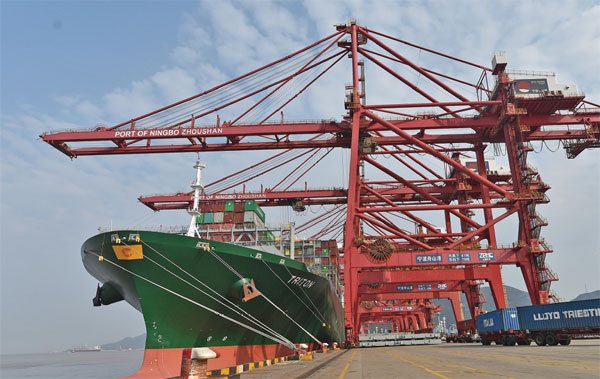Changing narrative
Surprise upside in second-quarter GDP figures sets the course for rise in annual growth
Is China's economy gaining new momentum? Many of the assumptions have been that the country's growth was on a steady downward trajectory as its economy matures.
Yet China's GDP grew by 6.9 percent in the second quarter, according to figures released by the National Bureau of Statistics on July 17, equaling its performance in the first.
The economy is now on course to return increased annual growth for the first time since 2010 if this new buoyancy carries through to the second half of the year.
|
Containers pile up at Ningbo Zhoushan port. China's GDP grew by 6.9 percent in the second quarter, according to figures released by the National Bureau of Statistics on July 17, equaling its first-quarter performance. Huang Zongzhi / Xinhua |
The Washington-based financial institution also raised its 2018 forecast by 0.2 percentage point to 6.4 percent.
Li Daokui, an influential Chinese economist and director of the Center for China in the World Economy at Tsinghua University, believes that the country is now poised for a "golden" phase of economic recovery and expansion.
He argues that ongoing supply-side structural reform, including cutting excess capacity in the economy, and with local governments expected to be more proactive after the 19th Congress of the Communist Party of China in the autumn, growth could once more go back above the 7-percent mark last seen in 2014.
"(The) Chinese economy will bottom out this year and regain strong growth momentum in 2018 and 2019, and possibly rise above 7 percent," he says.
Increased China growth - which between 2011 and 2015 represented 25 percent of global GDP growth - could provide a major boost to European companies and African commodity producers.
The announcement of the higher-than-expected growth figures buoyed international stock markets. The FTSE index in London finished 0.4 percent higher at 7,413.42.
Commodity prices also received a spur, with copper hitting $6,000 (5,110 euros; £4,600) a metric ton for the first time since March.
Stephen Roach, senior fellow at Yale University's Jackson Institute for Global Affairs, says the recent figures do change the narrative about the Chinese economy.
He points out that China's GDP has fallen at an average rate of 0.6 percentage point a year since it peaked at 10.6 percent in 2010.
"Chinese economic growth was widely expected by many analysts to stay on that downward trajectory for the foreseeable future," he says.
"It is always risky making too much out of one or two quarters of economic growth, but there can be no mistaking the impressive resilience of the Chinese economy in the first half. A modest acceleration to 6.9 percent not only breaks the downtrend - albeit by a relatively small margin - but it would draw the worst-case scenario of an imminent growth implosion into serious question."
Roach, also author of Unbalanced: The Co-Dependency of America and China, says China has been boosted by stronger than expected global growth, which has acted as an external brake since the onset of the global financial crisis in 2008. China's exports in June were up by 11.3 percent year-on-year.
"The pessimistic consensus view on China has fixated on the twin headwinds of deleveraging and a related tightening of the property market. While those negative forces have, indeed, come into play, they have been more than offset by an improving global climate and its attendant impetus to Chinese exports, as well as the ongoing structural transformation of an increasingly consumer-led growth dynamic."
Louis Kuijs, Hong Kong-based head of Asia Economics at Oxford Economics, upgraded his own 2017 GDP forecast from 6.6 to 6.8 percent after the latest figures were announced.
"It does change the narrative, if only in the short term. Most China analysts had been expecting a slowdown throughout the year after a strong start, but it is now looking to be significantly less pronounced," he says.
"Apart from the support from exports, there was resilience in real estate, especially in the smaller cities. These cities have not been much affected by the house purchasing restrictions that have been imposed in places like Beijing and Shanghai."
Zhu Ning, Oceanwide professor of finance at Tsinghua University, however, does not think the new data changes the outlook for the economy drastically, since some of it he agues has been driven by credit.
"Once the stimulus or short-term credit expansion tapers off, the economy will probably lose this short-term momentum," he says.
Zhu, who is also author of China's Guaranteed Bubble, an examination of some of the stresses in the Chinese financial system, says growth depends on how successful policymakers are in delivering supply-side reforms and a rebalancing of the economy.
"The future drivers of growth will be innovation, internationalization and further reform of the financial sector, which is important, or critical, to improve productivity."
Jeremy Stevens, Beijing-based China economist of Standard Bank, Africa's largest bank, doubts whether the current upturn in growth signals that some sort of bottoming-out point has been reached in China's growth decline and that it will now start increasing.
"If the Chinese economy expands by 6.9 percent this year, which I still think is unlikely, some will argue a bottom has been reached. However, despite some real credible progress in terms of reforms and the transition of the economy toward consumption and services, the reality is that we have declining productivity, which will limit future growth potential."
The increase in growth makes it more likely that the Chinese government will achieve its target of becoming a "moderately well-off society" by the end of 2020 in time for the 100th anniversary of the founding of the Communist Party of China the following year
This involves the doubling of the 2010 per capita income and is seen as a proxy for breaking out of the so-called middle-income trap, which has ensnared many developing countries, particularly in Latin America.
If it does meet the target, China would be classified as a high-income country, although its per capita income would still remain well below that of many advanced economies.
Roach at Yale says many countries fail to get through this barrier because they over-optimistically regard the "takeoff " model of their early industrialization as good enough to achieve the breakthrough.
"China understands the need to change the model as it nears the frontier of this middle-income threshold mainly by shifting its focus from the adoption of imported technologies to a growth impetus supported by more indigenous innovation."
The former Asia head of Morgan Stanley says the firm evidence of this is Made in China 2025, aimed at developing advanced manufacturing, and Internet Plus to develop its internet services sector.
"These efforts underscore China's focus on an innovations-based solution to its longstanding and more symbolic national target of a "well-off society"," he adds.
Zhu at Tsinghua says the unexpected GDP growth now gives China the opportunity to achieve the target comfortably.
"We are now well on track for this and this relieves the pressure on the GDP numbers that have to be achieved up to the target date, and there can be more focus on the actual quality of the growth."
One of the concerns about China's renewed growth momentum has been how much it has been fueled by credit expansion.
China's debt to GDP ratio by some measures is now 260 percent of GDP, compared with 141 percent in 2008 before the financial crisis.
But China's financial system still has major liquidity with private and corporate savings equivalent to about 75 percent of the total of the United States and the European Union combined.
President Xi Jinping made clear in his speech to the five-yearly National Financial Work Conference on July 15 his determination to rein in the debt of China's State-owned enterprises.
Some believe the stronger performance of the Chinese economy this year gives the financial authorities greater scope to tackle debt.
Roach at Yale believes Xi is right to focus on SOE borrowing, since it is one of the major sources of debt in the economy.
He believes China is in a much better position to deal with its debt than Japan, which has never fully recovered from its crash nearly 30 years ago. He points out that Japan's gross government debt (that owed by central government) of 239 percent is nearly five times that of China's 49 percent.
"Just as Japan has been able to sidestep a sovereign debt crisis, China with its far larger savings cushion is in much better shape to avoid an implosion," he says.
Stevens at Standard Bank believes the authorities have made major strides to deal with China's debt issues.
"While it is impossible to guarantee the success of their measures, the signs continue to be promising that they have conviction in their desire to rein in excess debt," he says.
"As long as new credit finds its way to productive uses and to the real economy, the chances are good that the authorities can divert the economy from any day of reckoning."
Duncan Innes-Ker, London-based regional director for Asia for the Economist Intelligence Unit, thinks financial tightening will continue and there will be more of a crackdown next year.
"We have certainly seen some marginal tightening of credit conditions with interbank borrowing rates rising slightly and a crackdown on the gray financing market. We believe the monetary tightening will continue, most likely at a slightly faster pace, after the Congress."
For Kuijs at Oxford Economics, if any stresses in the system become apparent, it would be seen with withdrawal of deposits from the banking system.
"If you saw a tapering off of deposits, it would be a sign of people losing faith in the financial system. So far, however, everything is held together by this wonderful flow of easy liquidity into the system from the deposits of companies and individuals."
Miranda Carr, senior analyst at Haitong Securities in London and a leading China economist, believes one of the major risks for the economy could be consumer debt.
She points out that consumer loans now amount to 1.3 trillion yuan (165 billion euros, $192 billion), up 140 percent year-on-year. Many Chinese consumers are talking advantage of short-term loan facilities such as Tenpay and Alipay offered by China's e-commerce giants. Consumer debt now makes up around 12.8 percent of GDP.
"Part of the government's aim is to rebalance the economy toward more consumer spending, making the economy less dependent on exports and investment. There are risks here, however," she says.
"All other debt in the economy, including that of the State-owned enterprises, is backed by the State; consumer debt is not and it is unsecured. We just do not know how consumers are going to behave. The experience of other Asian economies like Taiwan, Hong Kong and South Korea is that this becomes a problem."
Roach is convinced the upturn in the economy is the result of the government pursuing a consistent economic policy, particularly in relation to its overall rebalancing strategy, and that was now paying a dividend in increased growth.
"While there have been some setbacks along the way - especially in the financial system with the bursting of the Chinese equity bubble in 2015 and the re-imposition of partial capital controls in late 2016 - the Chinese leadership has been steadfast in staying the course of this strategic rebalancing."
andrewmoody@chinadaily.com.cn

















